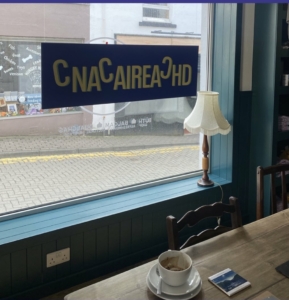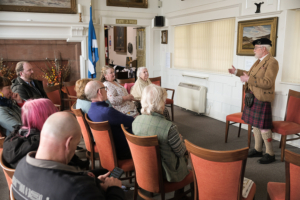Sùil air: Urras Leasachaidh Sgìre Thaigh na Bruaich – Ainmean-àite Sgìre Chill Fhionain // Case Study: Tighnabruaich District Development Trust – Place Names of Kilfinan
Air Seachdain na Gàidhlig, le taic bho Mhaoin nan Tabhartas Beag (Bòrd na Gàidhlig), bha seisean aig Urras Leasachaidh Sgìre Thaigh na Bruaich air ainmean-àite na sgìre. Thàinig mu 35 duine agus chuir iad seachad beagan ùine a’ coimhead air ainmean-àite, ainmean aibhne is bheanntan agus a’ coimhead air a’ mhapa. Bha mòran seann luchd-còmhnaidh ann a bha comasach air tòrr fiosrachaidh inntinneach a thoirt mu na h-àiteachan, agus dè an t-ainm a bh’ orra, a bharrachd air eachdraidh eile. Bha ùidh cho mòr aig daoine anns na còmhraidhean a bha iad a’ faighinn. Bha gu leòr bèicearachd dachaigh ann agus bhrosnaich seo daoine gus fuireach agus cabadaich.
B’ e madainn a bh’ ann airson tòiseachadh air a’ bhuidheann Ghàidhlig agus Pròiseact Buidheann Dualchais airson rannsachadh agus clàradh ainmean-àite ann an Sgìre Chille Fhionain.
Chuir 18 neach air ainm a chuir a-steach airson bùth-obrach gus barrachd ionnsachadh mu mar a nì thu sgrùdadh air ainmean-àite gus an tèid an rannsachadh a dhèanamh gu cruaidh. Thèid am fiosrachadh fhoillseachadh ann an Gàidhlig agus Beurla an dà chuid mar bhileagan/fiosrachadh, agus mar thaisbeanadh san Ionad Dualchais ann an Taigh na Bruaich.
//
On Seachdain na Gàidhlig, with support from the Small Grants Fund (Bòrd na Gàidhlig), Tighnabruaich District Development Trust ran an informative session on place names of the area. 35 people came along and spent time looking at place names, river names and hill names and observing them on the map. Several older residents were able to share lots of interesting information on the places, their names, as well as their history. People were hugely interested in the conversations that were had. A good load of home baking encourages people to stay longer to chat.
It was a great day to start a Gaelic group and the heritage group project on researching and recording place names in Kilfinan.
18 people signed up for a later workshop to learn how to examine place names to an excellent level of research. The information will be published in Gaelic and English in booklets and will be displayed as an exhibition in the Heritage Centre in Tighnabruaich.




























